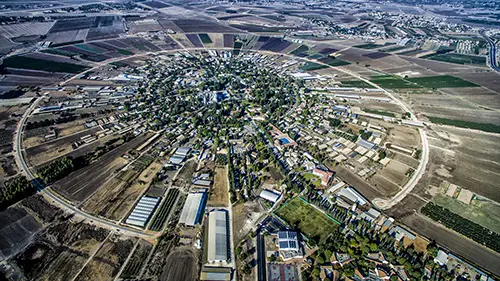The Moshav

The first moshav (plural, moshavim), Nahalal, was established in the Jezreel, or Yizreel, Valley (Emeq, Yizreel is also seen as the Valley of Esdraelon in English) on September 11, 1921. According to the Center for Israel Education, the initial settlers wanted to combine the communal principles of the kibbutz with private ownership. Each family received 25 acres on which to farm and was expected to work by themselves without paid labor but could rely on other landowners for help if needed. Communal areas were built in the center of the moshav, with homes surrounding it and fields beyond them.
Today, there are more than 400 moshavim. There are two types, the more numerous (405) moshavim ovdim and the moshavim shitufim. The former relies on cooperative purchasing of supplies and marketing of produce; the family or household is, however, the basic unit of production and consumption. The moshav shitufi form is closer to the collectivity of the kibbutz: although consumption is family-or household-based, production and marketing are collective. Unlike the moshavim ovdim, land is not allotted to households or individuals but is collectively worked.
Because the moshav form retained the family as the center of social life and eschewed bold experiments with communal child-rearing or equality of the sexes, it was much more attractive to traditional Oriental immigrants in the 1950s and early 1960s than was the more communally radical kibbutz. For this reason, the kibbutz remained basically an Ashkenazi institution, whereas the moshav did not. On the contrary, the so-called immigrants' moshav (moshav olim) was one of the most-used and successful forms of absorption and integration of Oriental immigrants, and it allowed them a much steadier ascent into the middle class than did life in some development towns.
Like the kibbutzim, moshavim, since 1967, has relied increasingly on outside--particularly Arab--labor. Financial instabilities in the early 1980s hit many moshavim hard, as did the problem of absorbing all the children who might wish to remain in the community. By the late 1980s, more and more moshav members were employed in nonagricultural sectors outside the community, so some moshavim were coming to resemble suburban or exurban villages whose residents commute to work. In general, moshavim never enjoyed the elite status accorded to kibbutzim; correspondingly, they did not suffer a decline in prestige.
Sources: Library of Congress.
Moshav Nahalal Is Founded,
Center for Israel Education.
Photo: ZeevStein, CC BY-SA 4.0 via Wikimedia Commons.


